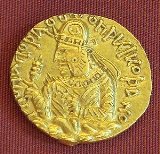
Huvishka
Encyclopedia
Huvishka was a Kushan emperor from the death of Kanishka
(assumed on the best evidence available to be in 140 CE) until the succession of Vasudeva I
about forty years later. His rule was a period of retrenchment and consolidation for the Empire. In particular he devoted time and effort early in his reign to the exertion of greater control over the city of Mathura. Mathura represented the southernmost extent of the Empire and, like much of the Indian Subcontinent
, had been ruled via a series of subordinate rulers. These rulers, the ksatraps, maintained a certain amount of autonomy up under Kanishka, but they vanish from records in Huvishka's reign, while Huvishka patronised both Buddhist and Brahmin institutions in the town.
, on the bottom part of a 2nd century statue which has been found in Govindo-Nagar, and now at the Mathura Museum. The statue is dated to "the 28th year of the reign of Huvishka", and dedicated to "Amitabha Buddha" by a family of merchants.
Compared to his predecessor Kanishka, Huvishka seems to rely less on Iranian deities (which are much less numerous in his coinage), and more on India ones, such as war divinities of Shivaism.
He also incorporates in his coins for the first and unique time in Kushan coinage the Hellenistic-Egyptian Serapis
(under the name Σαραπο, "Sarapo" ), and the Goddess Roma
(thought to represent "Roma aeterna"), under the name "Riom" (Greek: ΡΙΟΜ).
One of the great remaining puzzles of Huvishka's reign is the devaluation of his coinage. Early in his reign the copper coinage plunged in weight from a standard of 16g to about 10-11g. The quality and weight then continued to decline throughout the reign until at the start of the reign of Vasudeva the standard coin (a tetradrachm) weighed only 9g. The devaluation led to a massive production of imitations, and an economic demand for the older, pre-devaluation coins in the Gangetic valley. However, the motivation (and even some of the details) of this devaluation are still unknown.
Kanishka
Kanishka ) was an emperor of the Kushan Empire, ruling an empire extending from Bactria to large parts of northern India in the 2nd century of the common era, and famous for his military, political, and spiritual achievements...
(assumed on the best evidence available to be in 140 CE) until the succession of Vasudeva I
Vasudeva I
Vasudeva I was a Kushan emperor, last of the "Great Kushans." Named inscriptions dating from year 64 to 98 of Kanishka's era suggest his reign extended from at least 191 to 225 CE....
about forty years later. His rule was a period of retrenchment and consolidation for the Empire. In particular he devoted time and effort early in his reign to the exertion of greater control over the city of Mathura. Mathura represented the southernmost extent of the Empire and, like much of the Indian Subcontinent
Indian subcontinent
The Indian subcontinent, also Indian Subcontinent, Indo-Pak Subcontinent or South Asian Subcontinent is a region of the Asian continent on the Indian tectonic plate from the Hindu Kush or Hindu Koh, Himalayas and including the Kuen Lun and Karakoram ranges, forming a land mass which extends...
, had been ruled via a series of subordinate rulers. These rulers, the ksatraps, maintained a certain amount of autonomy up under Kanishka, but they vanish from records in Huvishka's reign, while Huvishka patronised both Buddhist and Brahmin institutions in the town.
Religion
The reign of Huvishka corresponds to the first known epigraphic evidence of the Buddha AmitabhaAmitabha
Amitābha is a celestial buddha described in the scriptures of the Mahāyāna school of Buddhism...
, on the bottom part of a 2nd century statue which has been found in Govindo-Nagar, and now at the Mathura Museum. The statue is dated to "the 28th year of the reign of Huvishka", and dedicated to "Amitabha Buddha" by a family of merchants.
Compared to his predecessor Kanishka, Huvishka seems to rely less on Iranian deities (which are much less numerous in his coinage), and more on India ones, such as war divinities of Shivaism.
He also incorporates in his coins for the first and unique time in Kushan coinage the Hellenistic-Egyptian Serapis
Serapis
Serapis or Sarapis is a Graeco-Egyptian name of God. Serapis was devised during the 3rd century BC on the orders of Ptolemy I of Egypt as a means to unify the Greeks and Egyptians in his realm. The god was depicted as Greek in appearance, but with Egyptian trappings, and combined iconography...
(under the name Σαραπο, "Sarapo" ), and the Goddess Roma
Roma (mythology)
In traditional Roman religion, Roma was a female deity who personifed the city of Rome and more broadly, the Roman state. Her image appears on the base of the column of Antoninus Pius.-Problems in earliest attestation:...
(thought to represent "Roma aeterna"), under the name "Riom" (Greek: ΡΙΟΜ).
Coinage
One of the great remaining puzzles of Huvishka's reign is the devaluation of his coinage. Early in his reign the copper coinage plunged in weight from a standard of 16g to about 10-11g. The quality and weight then continued to decline throughout the reign until at the start of the reign of Vasudeva the standard coin (a tetradrachm) weighed only 9g. The devaluation led to a massive production of imitations, and an economic demand for the older, pre-devaluation coins in the Gangetic valley. However, the motivation (and even some of the details) of this devaluation are still unknown.
Bodh Gaya
Decorated coins of Huvishka were found at Bodh Gaya together with other gold offerings under the "Enlightenment Throne" of the Buddha. This would tend to suggest direct Kushan influence in the area during the 3rd century CE.External links
- Online Catalogue of Huvishka's Coinage
- Coins of Huvishka
- http://www.kushan.org/essays/huvishka/huvishka.htm Was Huvishka sole king of the Kushan Empire
- http://www.kushan.org/coins/huvishka/devaluation.htm The Devaluation of the Coinage of Kanishka

